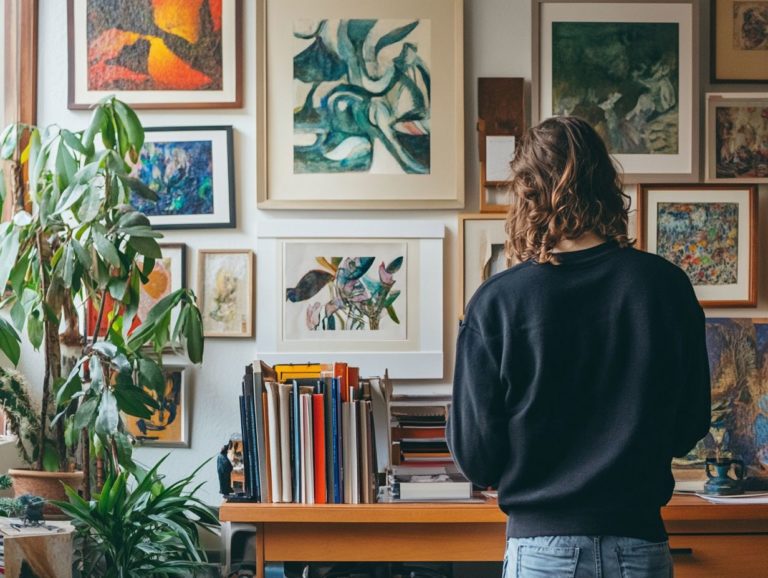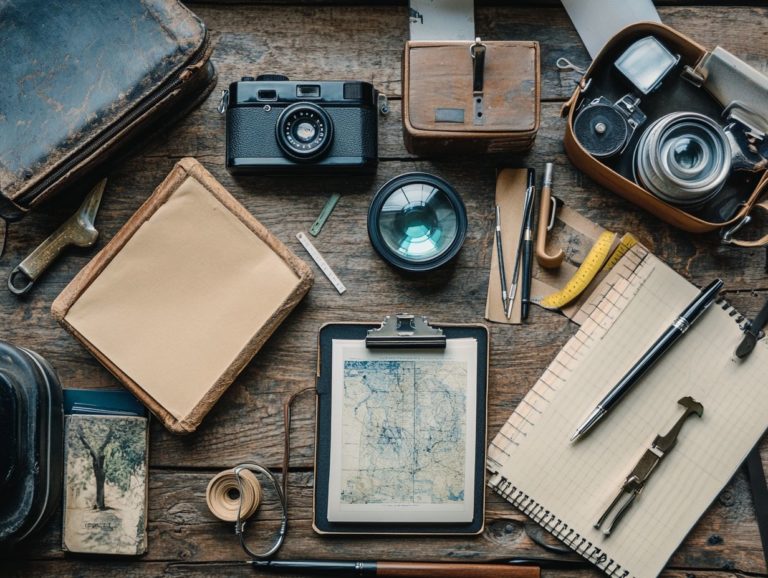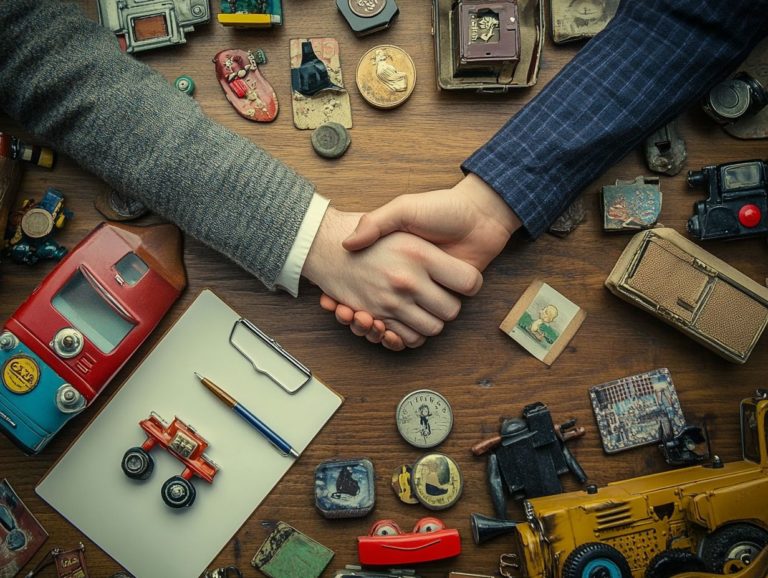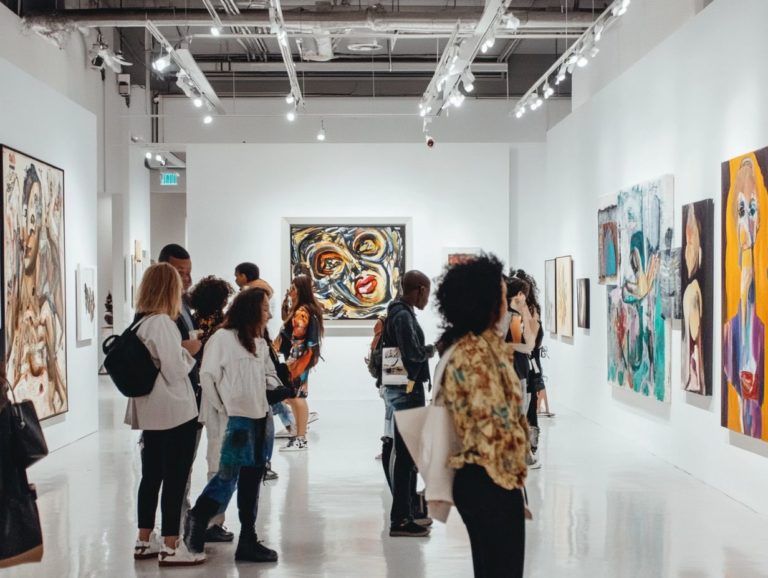How to Spot Fake Art: A Collector’s Guide
Art possesses the remarkable ability to stir profound emotions while also serving as a noteworthy investment. Yet, how can you ascertain the authenticity of your purchase?
This guide delves into the essence of genuine art. It equips you with the insights needed to identify inauthentic pieces. From visual cues to concerns about the history of the artwork, you will learn how to effectively research artists and verify the histories of artworks.
Uncover techniques and practical tips to safeguard yourself against fraudulent purchases. Whether you re a seasoned collector or just starting out, grasping these elements will elevate your art-buying experience.
Contents
Key Takeaways:
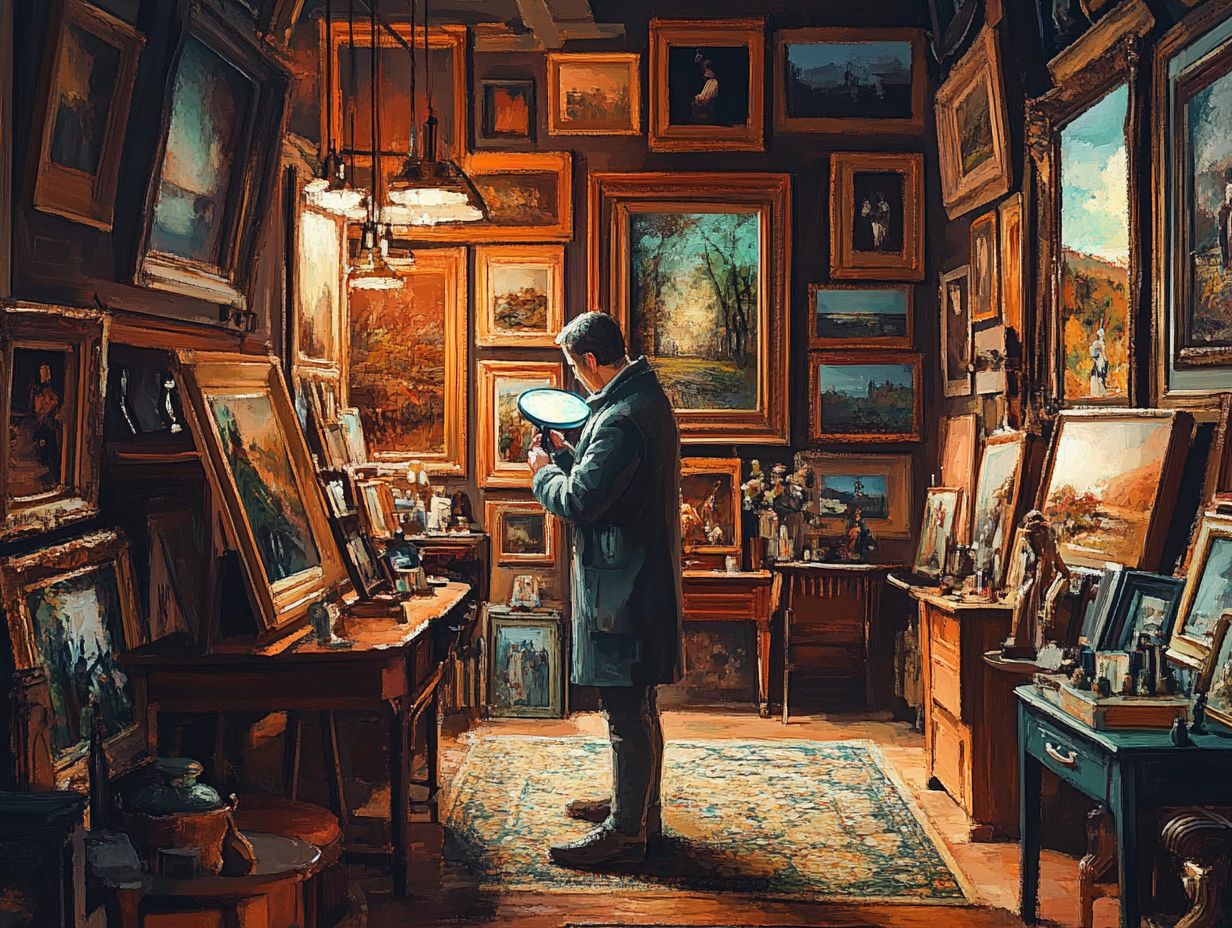
Learn the characteristics of authentic art and what sets it apart from fake pieces.
Be aware of visual indicators and red flags in the artwork’s history to spot fake art.
Conduct thorough research on the artist and artwork to verify their history.
Understanding Authentic Art
Understanding authentic art is crucial for collectors and investors. It protects the value and integrity of your collection.
Authentic art refers to original works that can be traced back to the artist. These come with verified documents proving their history.
In an age where art forgery is common, your ability to authenticate a piece is vital for preserving its worth and significance.
To understand authenticity, examine various factors:
- Signature verification
- The materials used
- The crucial role played by trusted galleries and art appraisers
What Makes Art Authentic?
Art reaches its peak of authenticity when it is genuinely created by the artist it claims to represent. This authenticity is validated through signatures, the history of the artwork, and documents that prove the artwork is real.
For collectors, this validation process is paramount when investing in original art. It ensures that what you acquire is valuable and true to its origins.
An artist’s signature acts as a personal stamp, showcasing their unique style and intent. Meanwhile, documents tracing the artwork’s history establish its legitimacy and market value over time.
Certificates of authenticity further support this narrative. They provide assurance that the piece is indeed an original, crafted by the esteemed artist. These elements transform simple objects into cherished investments that resonate with cultural and historical significance.
Signs of Fake Art
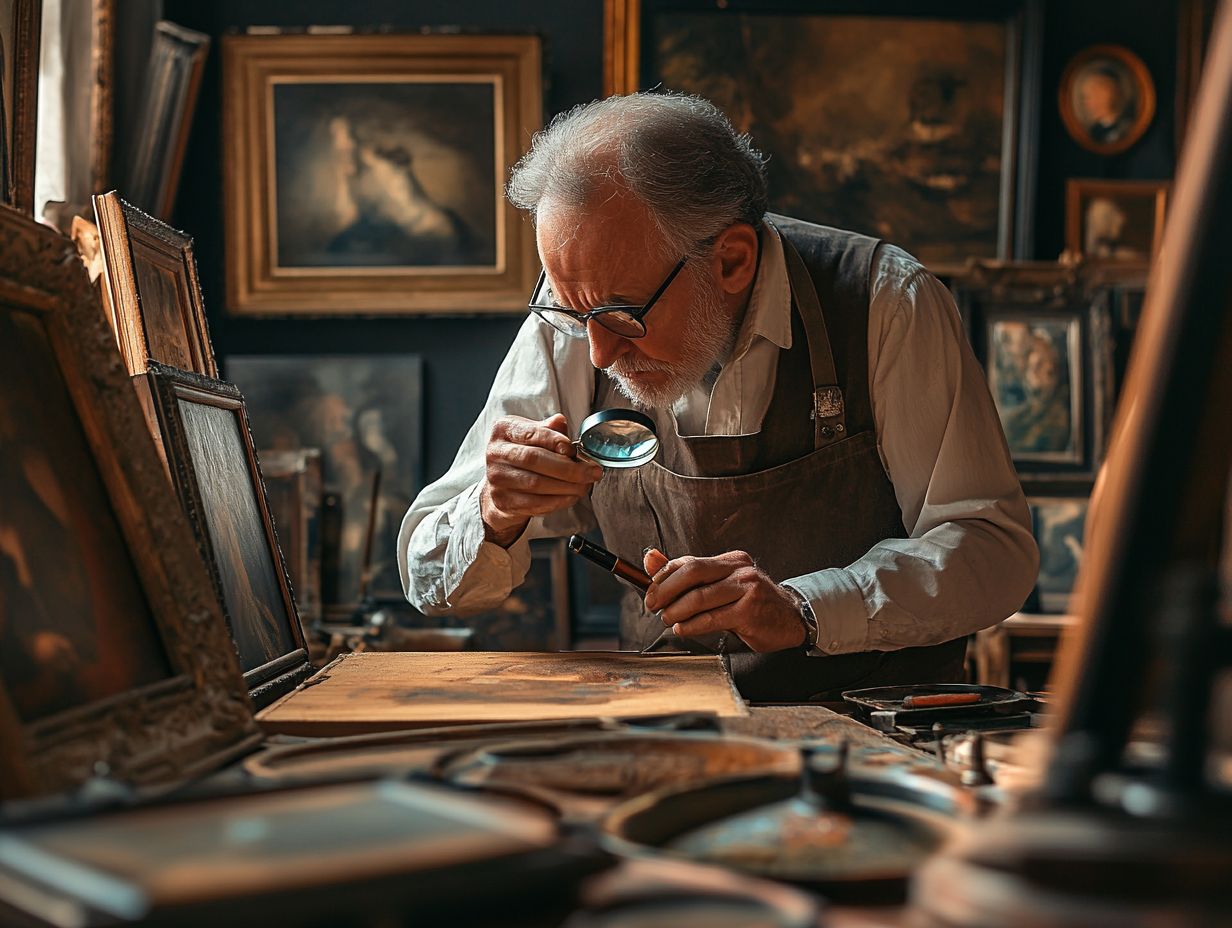
Spotting fake art is essential for protecting your valuable collection! Understanding the art market and identifying the signs of fake art helps safeguard your investments from forgeries that could undermine their value.
While counterfeit artwork can masquerade as original pieces, a meticulous visual analysis combined with a solid understanding of the artwork’s history can unveil hidden discrepancies.
Familiarizing yourself with the traits of known forgeries is essential for discerning authentic works from inauthentic ones.
Visual Indicators of Inauthenticity
Visual indicators are key for identifying inauthentic art. Elements such as brushstrokes, color inconsistencies, and canvas textures can reveal whether a piece is genuinely original or merely a clever imitation.
Art appraisers depend on their finely honed instincts to scrutinize these visual details, as they often expose hidden truths about a work s origin. For instance, examining brushstrokes can reveal whether the artist used traditional techniques or modern tools choices that could betray the claimed period of creation.
If you notice inconsistencies in color saturation, it could hint at synthetic pigments that weren t available during the artist s era. By employing meticulous visual analysis, experts enhance their ability to distinguish authenticity from imitation, ensuring that real treasures aren’t overlooked.
Red Flags in the Provenance
Red flags in provenance can serve as your first indication that a piece of art might not be genuine. Inconsistencies in ownership history and a lack of verification from reputable auction houses can raise your suspicions.
These indicators remind you that not all documentation carries the same weight. Reliable provenance provides a clear and traceable path detailing previous owners, exhibitions, and sales, all backed by credible sources.
When documentation fails to include critical details or presents unverifiable claims, it undermines the historical authenticity of the piece, potentially diminishing its value. Auction houses prioritize thorough checks to ensure legitimacy. Therefore, approach your scrutiny with diligence.
Seek comprehensive reports or certificates from trusted experts. The integrity of the artwork is crucial for making a smart investment.
Researching the Artist and Artwork
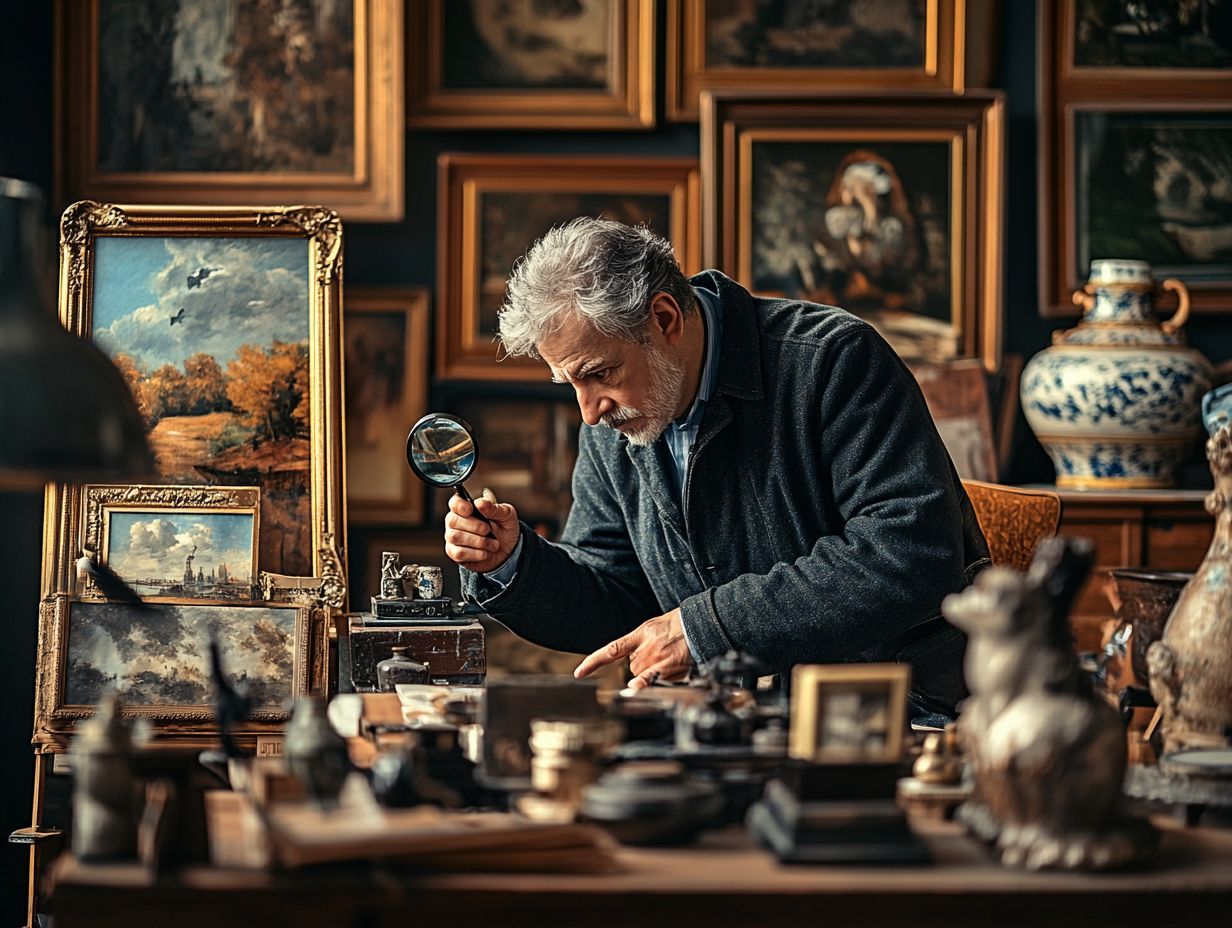
Researching the artist and their artwork is a crucial step in your art-buying journey. This process offers valuable insights into the piece’s provenance, authenticity, and overall market value.
By diving into the artist’s background and the context surrounding the artwork, you elevate your buying experience. Art historians and appraisers stress the importance of thorough research, guiding you toward informed and confident decisions when investing in original art.
How to Verify the Artist and Artwork’s History
To verify the history of the artist and their artwork, consult trusted galleries and art historians. They can provide invaluable insights and documentation related to provenance.
This process typically starts with thorough research into the artist’s background, including their exhibitions and critical reception.
Engaging with reputable galleries that showcase the artist’s work is crucial. They often maintain archives of exhibition catalogs and past sales that serve as reliable references.
Discussions with art historians reveal lesser-known facts about the artist’s influences and techniques.
Obtain certificates of authenticity or appraisals from recognized experts in the field. This step is wise for securing your investment.
Leveraging these resources keeps you well-informed and aids in making secure investments in the art world.
Tools for Detecting Fake Art
You ll find a range of sophisticated tools designed to detect fake art. These tools utilize advanced scientific analysis techniques like infrared reflectography, which uses infrared light to see underneath the surface of a painting, X-ray, and mass spectrometry.
These methods prove invaluable for art appraisers and collectors seeking to safeguard their investments and ensure authenticity.
Techniques and Technologies Used by Experts
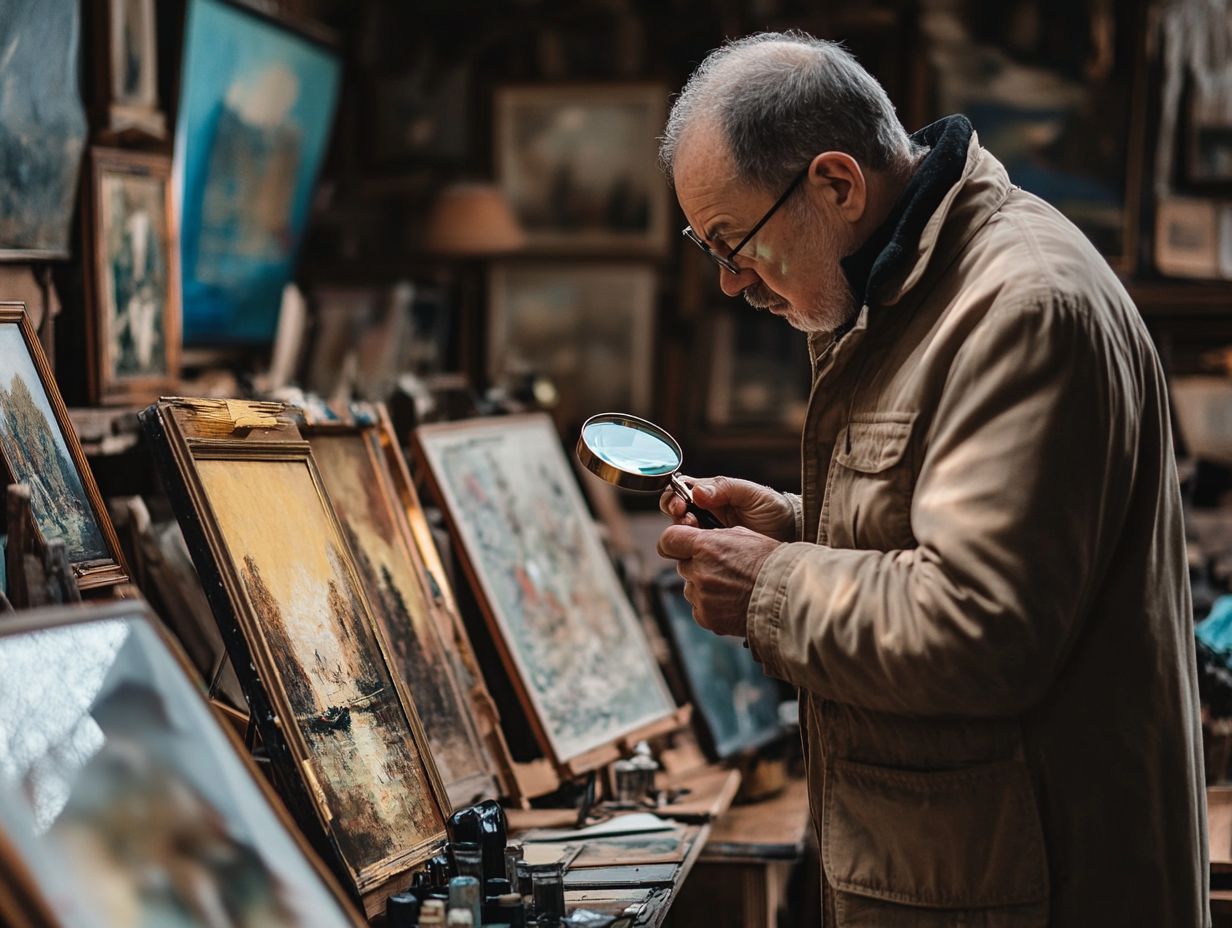
Experts utilize a range of sophisticated techniques and technologies to detect fake art. They employ scientific analysis methods like infrared reflectography and X-ray imaging to reveal details hidden from the naked eye.
By leveraging these cutting-edge tools, you can delve into the layers of paint and canvas structure. This uncovers critical insights into an artwork’s history and authenticity. For example, ultraviolet light can help spot alterations or repairs that suggest tampering.
Scientific methods such as pigment analysis and spectroscopy provide vital information regarding the materials used. This allows you to trace the origins of the pigments with precision.
This varied approach enhances authentication accuracy and fortifies trust in the art market. It enables collectors and investors to make informed decisions based on reliable evidence.
Protecting Yourself from Fake Art
You must protect yourself from counterfeit art. Employing effective buying strategies can greatly mitigate the risk of acquiring inauthentic pieces.
Recognize the potential for art forgery now to safeguard your investments! Always turn to reputable galleries that offer certificates of authenticity. This not only safeguards the integrity of your collection but also upholds its value over time.
Start your art-buying journey today by researching, consulting with experts, and making informed decisions.
Tips for Avoiding Fraudulent Art Purchases
To steer clear of fraudulent art purchases, prioritize acquiring art from trusted galleries. Ensure that every piece comes with proper documentation, including certificates of authenticity.
Researching the history of each artwork is essential. A detailed history can unveil potential red flags regarding its legitimacy.
Engaging with reputable appraisers or art consultants provides valuable insights into an artist’s body of work and current market trends. Knowledgeable advisors are crucial during the verification process.
Utilizing online databases dedicated to tracking stolen art or forgeries is a proactive approach that can safeguard your investments. Always consider requesting a digital image of a past exhibit or notable sale to substantiate authenticity.
This care boosts your confidence and significantly protects your investment in the art world.
Watch this video to learn more about spotting fake art.
Frequently Asked Questions
What is the importance of knowing how to spot fake art?
As a collector, it’s vital to spot the difference between authentic and fake art to avoid spending money on fraudulent pieces. Understanding how to spot fake collectibles also protects the value and integrity of your collection.
What should I look for when examining a piece of art?
When examining a piece of art, pay attention to details such as brushstrokes, signatures, and overall quality. Fakes often lack the same skill and precision as authentic pieces.
Are there any specific techniques used by forgers to create fake art?
Yes, forgers often use techniques such as aging the canvas or pigments, creating false histories, and replicating the artist s signature to make the fake art appear more convincing. This is why it’s important to thoroughly examine all aspects of a piece before purchasing.
How can I research the authenticity of a piece of art?
Consulting with experts, such as art historians, appraisers, and dealers, is recommended to research the authenticity of a piece. They can provide valuable insights on the artist and their work.
Are there any red flags that indicate a piece of art may be fake?
Yes, look out for inconsistencies in the artist s style or technique, lack of provenance or documentation, and unusual or poor-quality materials.
What should I do if I suspect a piece of art in my collection is fake?
If you suspect a piece of art is fake, seek the advice of an expert. They can conduct further research and analysis to determine authenticity. If it is indeed a fake, act quickly to report it to the proper authorities to prevent others from falling victim to the same fraudulent piece.
Stay informed and consult an expert to ensure your art collection remains genuine!

